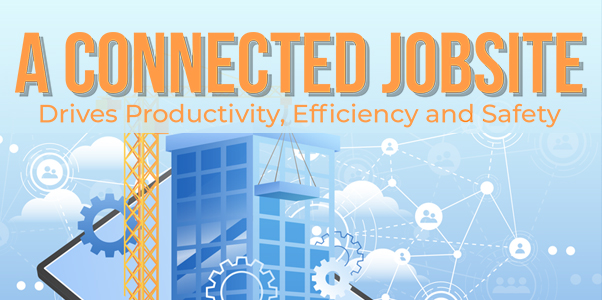
By Bob Haley and Chris Hann
The intense demand for new data centers is driving the need to build faster while maintaining safety. Meeting project sustainability goals is another top concern for investors, owners and contractors. A connected jobsite transforms data center builds, driving increased productivity, safety and security while paving a path to achieving lower greenhouse gas (GHG) emissions.
Data is the key to visibility and control. Real-time data produced by sensors, telematics devices and card readers and analyzed and presented by a cloud-based worksite management platform provides a 360-degree view of a project, including people and equipment. It allows companies to laser focus on opportunities to streamline operations, curb emissions and improve safety. At the same time, a connected jobsite enables the automation of processes, conserving labor hours and saving time and money.
SEAMLESS ACCESS MANAGEMENT
The biggest data center investors now demand access-controlled jobsites. Connected jobsite technology automates access control.
For example, modular smart turnstiles authenticate entrants and deliver the ability to efficiently monitor who’s on site. When an entrant scans a badge issued by a workforce management solution provider, a reader in the turnstile authenticates the person based on the profile associated with the badge and unlocks the gate. Smart turnstiles reduce the number of security personnel required at entry points and expedite faster site entry and departure. By verifying the presence of workers on site and the hours they worked, they also improve efficiency and accountability and promote smarter deployment of human resources.
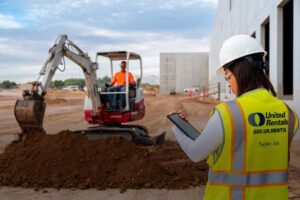 With some advanced worksite management platforms, user profiles from any third-party workforce management solution can be uploaded in a matter of minutes. Companies can then assign roles and privileges based on trade, training or other characteristics. As a result, the same RFID-enabled ID badges issued by the workforce management company can be used to restrict or grant access to the jobsite, to sensitive areas or zonesand even to equipment.
With some advanced worksite management platforms, user profiles from any third-party workforce management solution can be uploaded in a matter of minutes. Companies can then assign roles and privileges based on trade, training or other characteristics. As a result, the same RFID-enabled ID badges issued by the workforce management company can be used to restrict or grant access to the jobsite, to sensitive areas or zonesand even to equipment.
SINGLE-BADGE ACCESS TO JOBSITES AND EQUIPMENT
Controlling access to forklifts, excavators and other pieces of equipment improves site safety. Leveraging RFID-enabled ID badges for equipment access provides a host of benefits. Rather than enter a code on a keypad ignition lock, a worker an tap their badge on the lock’s card reader to unlock a piece of equipment they are authorized to operate. This saves companies from having to assign undreds or thousands of PINs, which are easily shared. Workers without authorization are prevented from operating the equipment, reducing the risk of injury and property damage.
Equipment access management creates a digital history of who used the equipment and when. This data trail increases accountability in the event a machine is damaged or left in the wrong place. It can also help support sustainability efforts by providing details such as who turned on a generator or other piece of equipment and how long it idled.
When keypads are added to restroom trailers and jobsite trailers, digital access management can help prevent vandalism and identify offenders.
OPTIMIZED EQUIPMENT PLANNING AND MAINTENANCE
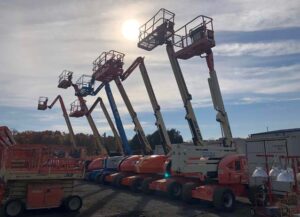
An efficient jobsite has the right type of equipment and the right mount of equipment. Utilization tracking enabled by a worksite management platform facilitates smarter fleet planning.
Telematics devices installed in equipment send engine hours or run times to the platform. Managers can then run utilization reports that clearly identify over or underutilized machinery and vehicles. They can leverage these reports to right-size and right-type their fleets. Selling or returning unnecessary equipment reduces costs and cuts waste, improving sustainability. Adding additional pieces of heavily utilized equipment reduces worker idle time, driving increased productivity.
Equipment may be so over utilized that workers hoard it, or so underutilized that it’s left out of sight and forgotten. GPS tracking shows the real-time location of all equipment on a map, allowing companies to maximize resources.
Data on engine hours and run times serves another purpose: facilitating just-in-time maintenance. A just-in-time approach optimizes maintenance schedules compared to time-based maintenance, potentially reducing resource consumption and helping prevent both over-maintenance and equipment-related downtime.
SIMPLIFIED EQUIPMENT SHARING
When a general contractor rents all the equipment necessary for a project and shares it with trade partners, the result is increased efficiency and productivity. Sharing allows the GC to derive the most value from each piece of equipment while helping subcontractors preserve uptime. Equipment access management makes it much easier. 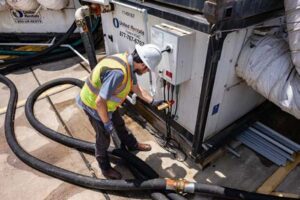
Normally, a GC that shares equipment must approve and process invoices for every individual piece of rental equipment used by each subcontractor. Utilization data produced by digital access control streamlines the process. A rental equipment vendor that offers a consolidated billing program can potentially free up hours of accounting staff time each month.
AUTOMATED EMISSIONS TRACKING
When it comes to reducing GHG emissions, identifying the best place to start can be challenging. Swapping out an entire fleet for lower-emission alternatives isn’t practical. In most cases, it isn’t even possible.
Identifying the largest sources of emissions on a jobsite lets companies make data-driven decisions about fleeting and fleet utilization and get the biggest return on their efforts. Tracking emissions also allows them to measure the results of steps such as switching to cleaner fuels or cleaner power generation equipment or choosing electric machines.
 Emission tracking can be a highly laborious process, however. It typically requires collecting fuel usage data from each subcontractor and performing manual calculations to determine estimated emission for each piece of equipment. A cloud-based worksite management platform that offers an estimated emissions dashboard changes the equation. Fuel use is estimated based on engine hours provided by telematics devices. Estimated emissions are then automatically calculated using a published emission factor for the fuel type.
Emission tracking can be a highly laborious process, however. It typically requires collecting fuel usage data from each subcontractor and performing manual calculations to determine estimated emission for each piece of equipment. A cloud-based worksite management platform that offers an estimated emissions dashboard changes the equation. Fuel use is estimated based on engine hours provided by telematics devices. Estimated emissions are then automatically calculated using a published emission factor for the fuel type.
Automated emissions tracking may free up workers for other tasks while providing insights critical to increasing sustainability.
STREAMLINED ENVIRONMENTAL MONITORING AND CONTROL
Monitoring and controlling temperature and humidity in onsite areas and storage warehouses is critical to protecting expensive, high tech equipment, and to ensuring successful concrete curing. Yet manual 24/7 monitoring is inefficient and time consuming.
A connected jobsite streamlines the process. Sensors placed in key locations—including in concrete pours—enable remote monitoring via smartphone, tablet or computer. Access to real-time temperature and humidity data at any hour of the day or night eliminates unnecessary trips to the jobsite or warehouse. Notifications alert users when levels exceed predetermined thresholds.
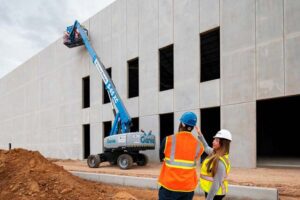 Remote temperature control goes a step further. Devices attached to smart heaters allow personnel to adjust heaters without setting foot on site. Turning heaters down or off when they aren’t needed saves fuel, which in turn cuts costs and reduces emissions.
Remote temperature control goes a step further. Devices attached to smart heaters allow personnel to adjust heaters without setting foot on site. Turning heaters down or off when they aren’t needed saves fuel, which in turn cuts costs and reduces emissions.
A COMPETITIVE EDGE
Given the intense competition for the multi-billion-dollar revenues generated by data center operation, speed to market matters. Companies that leverage the transformative power of digital technology during data center builds gain a critical edge.
Connected jobsites enable faster, safer, more efficient construction. From project start to project completion, they hold the power to streamline and automate processes, maximize resources, boost safety and facilitate increased sustainability. For companies seeking to gain every advantage, they are rapidly becoming a must.
Chris Hann is the Business Development Manager – Data Centers at United Rentals.
He can be reached at [email protected].